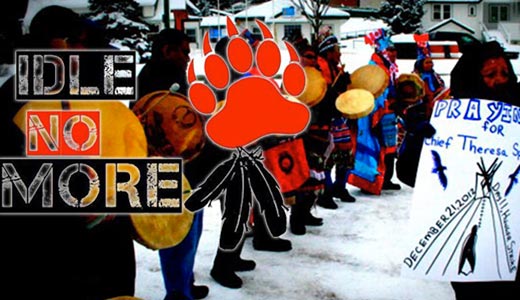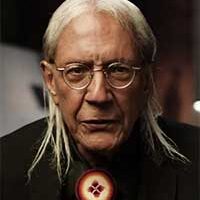
Idle No More is a Native protest movement that arose in Canada and is now engulfing that country and the U.S. Native communities from coast to coast in the U.S. have embraced this upheaval. Throughout our country, rallies of hundreds to thousands have performed traditional round dances flash mobs in support of INM, to the beat of drumming ,singing and chanting, in malls and other public venues. Some of these activities have taken place without incident and some have not. (Article continues below video)
Idle No More round dance at the Mall of America in Minnesota:
In certain parts of the country, most infamously Colorado and Minnesota, Native people have been barred from malls and even arrested for just “looking Native American.” This is an unspeakable outrage. Police were quoted as telling mall security, “If they look Native American, tell them to leave.” This is 1960s Mississippi-style racist police action directed against American Indian people for simply trying to assemble and exercise free speech in support of INM. Why isn’t there a national uproar? Native people of the U.S. are realizing that the civil rights progress of the 1960s in many respects bypassed Indigenous citizens.
The INM movement, started by four Indigenous women in November last year and now sweeping the Western Hemisphere at warp speed, was in response to the Canadian government’s Omnibus Bill C-45 that would further strip reservations of lands and also environmental protections. This infamous legislation was passed on December 14, after Assembly of First Nations (AFN) representatives were even barred from government meetings on the bill.
This led to a series of rallies and protests and a hunger strike by Attawapiskat Chief Theresa Spence demanding a meeting with Canadian Prime Minister Steven Harper and the Governor General on Aboriginal rights. Chief Spence is camping out in a tepee on an ice-covered island in the Ottawa River across from Parliament Hill, Canada’s seat of government.
In the meantime, the movement has sparked countless demonstrations and direct actions, including blockades of railways, roads and border crossings in Canada and rallies and flash mobs from coast to coast in the U.S. Suffice it to say that INM has morphed into the most massive Native American Indian movement in history. The movement is not new, but is the latest manifestation of centuries-old Native resistance to the exploitation, marginalization and continuous daily discrimination experienced by Indian citizens. Indeed, Native people have never forgotten that all of Canada and the U.S., two of the wealthiest nations in the world, is treaty land and that these two nations achieved their economic heights by using the land and resources of Indigenous nations that was for the most part illegally acquired.
On January 16 this year, INM held a national Day of Action that brought Canadian roads, railways and border crossings to a standstill with blockades. The blockades, though predominantly Indigenous, were often supported by non-Native participation. The movement, which started with Indian sovereignty and environmental protection, is now addressing a panoply of Native issues including poverty, suicides rates, joblessness, health and the protection of women. Media from around the world are covering INM.
But where, we may ask, is U.S. mainstream media coverage of this gigantic political movement? The “Buckskin Curtain” has struck again in an attempt to hide this immense social upheaval. But social media technology has circumvented the U.S. news machine. Indeed, INM support groups have arisen across the globe – throughout the Western Hemisphere from Alaska to the southernmost part of South America, to Europe, the Middle East, Asia, New Zealand and Australia.
In the latter 20th century the American Indian Movement and other freedom-seeking organizations ushered in a tremendous upsurge of Native activism resulting in the 1970 Mayflower takeover, the 1973 Trail of Broken Treaties, the 1973 Wounded Knee occupation and other defiant actions. Similarly the Idle No More movement may well bring about an even greater upheaval in the struggle for global justice for all oppressed peoples.
This is not just an Indian issue. The movement is reaching out to all justice-minded citizens to participate in INM, because the issues that are being fought for affect all the people of this earth.









